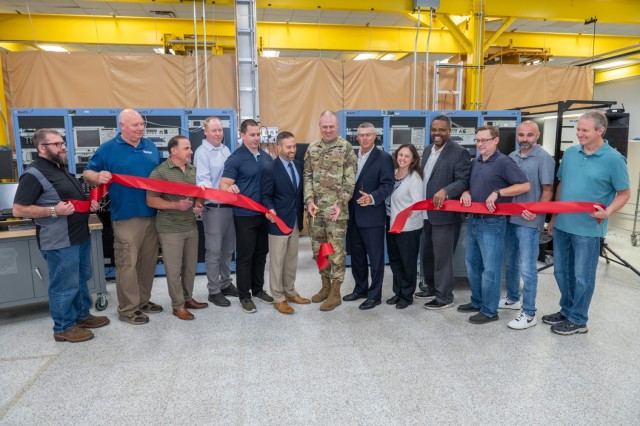Tobyhanna Army Depot, in collaboration with General Atomics Aeronautical Systems, Inc. (GA-ASI), proudly marked the successful launch of a critical unmanned aircraft system (UAS) maintenance, repair, and overhaul capability that strengthens support for a force that’s agile, modernized, and mission-ready.
Tobyhanna Army Depot hosted GA-ASI project leadership for a ribbon cutting on July 29 to formally commemorate the depot’s full test, diagnose, repair and return capability for the MQ-9 Reaper Ground Control Station’s Linux processors, file server, and control consoles.
This public-private partnership, or P3, directly aligns with Army and Department of Defense transformation initiatives seeking to facilitate a leaner and more agile Army through development of modernized UAS capabilities, as highlighted in the memo titled “Unleashing U.S. Military Drone Dominance.” In it, U.S. Secretary of Defense Pete Hegseth described drones as “the biggest battlefield innovation in a generation.”
The MQ-9 Reaper is a medium-large UAS supporting a payload of intelligence, surveillance, reconnaissance, and munitions equipment; this asset provides both intelligence and combat power to our warfighters on the battlefield of the future.
After being named the Depot Source of Repair for Shelters; Ground Electronics; Command; Control; Communications and Intelligence for Reaper Ground Control Systems in 2013, Tobyhanna’s work to develop this capability in coordination with GA-ASI began nearly a decade ago.
Over the course of the partnership, Tobyhanna and GA-ASI collaborated to develop technical manuals, training aides, specialized test equipment, and test program sets to facilitate efficient repair processes at Tobyhanna.
Joining an already vast portfolio of UAS capabilities, the success of this partnership is the latest in a long series of astute, forward-focused investments by depot leadership to proactively supplement the depot’s impressive capabilities, adapt to meet the needs of our nation’s warfighters, and reaffirm Tobyhanna’s position as a leading readiness provider for an evolving force and battlefield.
During remarks at the ribbon cutting ceremony attended by depot leadership and General Atomics representatives, Depot Commander Col. Benjamin L. Kilgore said endeavors like this one strengthen Tobyhanna’s position as a leading readiness provider across the joint force.
“I see Tobyhanna as a purple readiness provider, meaning we serve all branches of America’s armed forces. Just as America’s armed forces collectively serve to defend our nation, the success of this partnership is a testament to the collective effort of everyone in involved in this project,” said Kilgore.
He continued to say that Tobyhanna, bolstered by its dynamic civilian workforce, is ready to deliver excellent and efficient readiness to the next generation of warfighters.
“Today’s battlefield is rapidly transforming, yet Team Tobyhanna consistently raises the bar to deliver high-quality results. Your dedication and adaptability prove that Tobyhanna Army Depot can continue to thrive in a dynamic and challenging environment.”
This P3 is the latest of hundreds of partnerships fostered by the P3 program since its inception in 1994.
Christopher Volch, UAS Project Manager, emphasized that the success of the effort was driven by the dedication and contributions of the team members involved from start to finish.
“At every step, our people have been our greatest strength. In long-term efforts like this, not everything will always go according to plan; however, each team member met the challenges with remarkable resilience. The team’s dedication and collaborative approach reflect the core values of our organization and set the tone for Tobyhanna’s promising future supporting UAS products,” said Volch.
David King, General Atomics Senior Program Manager, U.S. Air Force Contractor Logistic Support, said it is rewarding to see years of hard work, determination, and collaboration between the two organizations pay off with a successful activation that will benefit warfighters today and tomorrow.
“People may not realize all it takes to stand something like this up,” said King. “There were challenges and lessons learned along the way, but what stands out to me is the great partnership fostered between Tobyhanna Army Depot and GA-ASI. We have the resources, the talent, and the capabilities. I am very proud of all involved.”
Tobyhanna Army Depot (TYAD) is designated as the Center of Industrial and Technical Excellence for Command, Control, Communications, Computers, Cyber, Intelligence, Surveillance and Reconnaissance (C5ISR), electronics, avionics, and missile guidance and control. TYAD provides cradle-to-grave lifecycle support through depot-level repair, systems integration, software and cyber engineering, and field support. A key enabler of operational readiness for Joint and Allied Forces globally, TYAD leverages new and emerging technologies to further expand the Department of Defense’s organic capabilities for microelectronics, secure communications infrastructure, unmanned aerial systems, Joint All-Domain Command and Control (JADC2), Integrated Air and Missile Defense (IAMD), and the Army’s Next Generation Combat Systems (NGC2). TYAD’s ability to rapidly surge production, deploy field support teams, and scale for contingency or theater-level operations makes it a vital contributor to strategic readiness and operational reach.




Social Sharing